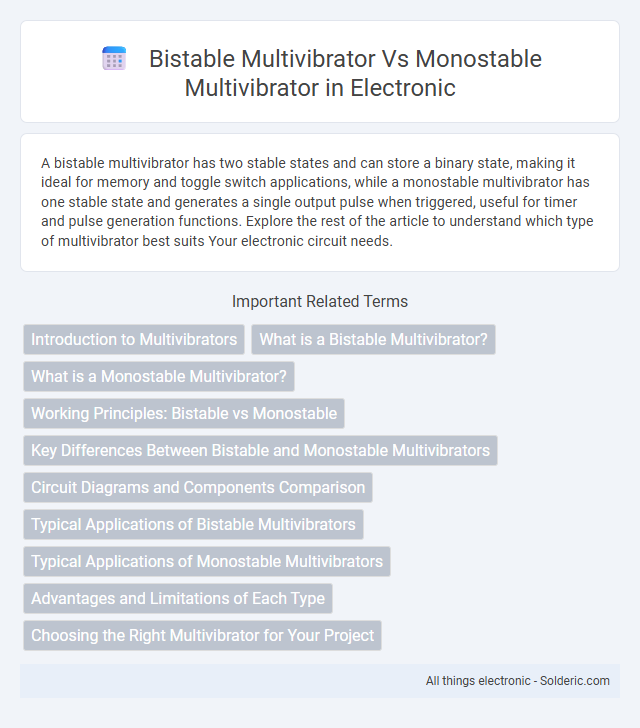A bistable multivibrator has two stable states and can store a binary state, making it ideal for memory and toggle switch applications, while a monostable multivibrator has one stable state and generates a single output pulse when triggered, useful for timer and pulse generation functions. Explore the rest of the article to understand which type of multivibrator best suits Your electronic circuit needs.
Comparison Table
| Feature | Bistable Multivibrator | Monostable Multivibrator |
|---|---|---|
| Operation | Two stable states; switches between states with an input trigger. | One stable state; generates a single output pulse per trigger. |
| Output | Continuous toggle between high and low states until triggered again. | Single timed pulse per input trigger. |
| Applications | Switch debouncing, flip-flops, memory elements. | Pulse generation, timers, delay circuits. |
| Trigger Type | Edge-triggered to toggle state. | Edge-triggered to produce timed pulse. |
| Stability | Two stable equilibrium points. | One stable equilibrium point. |
| Example ICs | 7400 series flip-flops (e.g., 7474) | 555 Timer IC in monostable mode |
Introduction to Multivibrators
Multivibrators are fundamental electronic circuits used to generate rectangular waveforms, with bistable and monostable types serving different applications. A bistable multivibrator, also called a flip-flop, has two stable states and can store binary information, making it essential in digital electronics for memory and switching. A monostable multivibrator, or one-shot pulse generator, has one stable state and produces a single output pulse when triggered, commonly used for timing and pulse shaping in your circuits.
What is a Bistable Multivibrator?
A bistable multivibrator is an electronic circuit with two stable states, capable of storing binary information by switching between these states when triggered. It functions as a flip-flop or latch, maintaining its output until an external signal causes it to change. You can use a bistable multivibrator for memory storage, digital switching, and timing applications where stable output states are essential.
What is a Monostable Multivibrator?
A monostable multivibrator is an electronic circuit that generates a single output pulse of fixed duration in response to an external trigger, making it a one-shot pulse generator. It features one stable state and one quasi-stable state, returning to its stable state automatically after the timed pulse ends. Common applications include timer circuits, pulse generation, and debounce circuits in digital electronics.
Working Principles: Bistable vs Monostable
A bistable multivibrator operates with two stable states, switching between them based on external inputs and maintaining its state until triggered again, making it ideal for memory storage and flip-flop applications. A monostable multivibrator has one stable state and one quasi-stable state, generating a single output pulse of a defined duration when triggered, commonly used for timing and pulse generation. Your choice depends on whether constant switching or single pulse output fits your electronic circuit needs.
Key Differences Between Bistable and Monostable Multivibrators
Bistable multivibrators have two stable states and can store a binary output, making them ideal for flip-flop circuits and memory storage. Monostable multivibrators possess one stable state and generate a single output pulse when triggered, commonly used for timing and pulse generation applications. Your choice depends on whether you need a device that maintains its state indefinitely or one that produces a timed output pulse.
Circuit Diagrams and Components Comparison
Bistable multivibrators utilize two cross-coupled transistors or logic gates to maintain two stable states, typically featuring components such as resistors, capacitors, and transistors arranged in a flip-flop configuration. Monostable multivibrators consist of a single stable state with a timing capacitor and resistor to produce a single output pulse when triggered, often incorporating a transistor or logic gate and a timing circuit to return to the stable state. The circuit diagram of a bistable multivibrator shows a feedback loop sustaining its state, while the monostable multivibrator includes a timing capacitor and resistor that control the pulse width before resetting.
Typical Applications of Bistable Multivibrators
Bistable multivibrators are widely used in digital circuits as flip-flops for data storage, toggling states between two stable conditions. They serve critical functions in memory elements, switch debouncing, and frequency division applications where stable binary output is essential. Their reliable state retention makes them integral to counters, storage registers, and control systems in electronics.
Typical Applications of Monostable Multivibrators
Monostable multivibrators are widely used in timing applications such as pulse generation, timers, and switch debouncing where a single output pulse of defined duration is required. They serve as one-shot pulse generators in digital circuits for producing precise time delays and waveform shaping. Common applications include frequency division, pulse-width modulation, and signal conditioning in communication systems.
Advantages and Limitations of Each Type
Bistable multivibrators offer the advantage of maintaining two stable states, making them ideal for memory storage and toggle switch applications, though their complexity can result in slower switching speeds. Monostable multivibrators generate a single output pulse for a specific input trigger, providing precise timing control with simpler design, but they cannot store states or operate continuously without retriggering. Your choice depends on whether stable state retention or controlled pulse generation fits your application requirements best.
Choosing the Right Multivibrator for Your Project
Selecting the right multivibrator depends on the required output pulse characteristics: bistable multivibrators offer two stable states ideal for toggle switches and memory storage, while monostable multivibrators provide a single stable state with a timed pulse output, suited for timer and pulse generation applications. Consider timing accuracy, circuit complexity, and application purpose to ensure optimal performance; for instance, monostable circuits excel in single-pulse timing, whereas bistable circuits are preferred for flip-flop operations. Understanding these functional differences enables precise control in digital electronics, control systems, and signal processing tasks.
bistable multivibrator vs monostable multivibrator Infographic

 solderic.com
solderic.com